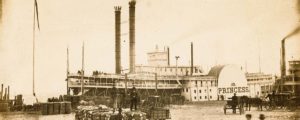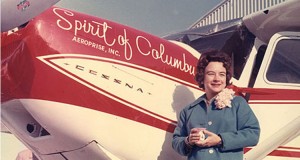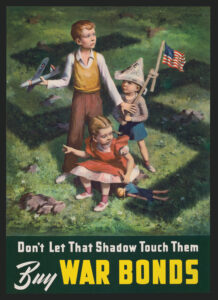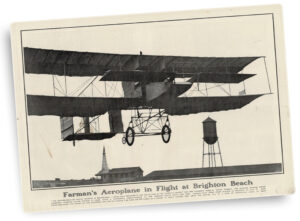Belvin Maynard’s 1919 victory inspired aviators across America—and made a hero of the ‘Flying Parson’.
Late in the morning on October 16, 1919, a de Havilland DH-4 dropped from the clouds and touched down silently in a pasture near Wahoo, Nebraska. A tall man wearing riding breeches clambered out of its front cockpit, and from the rear a mechanic and a large dog emerged. The two men headed for the biplane’s nose to gaze upward at their crippled engine. A broken crankshaft, unrepairable. Newspapers across America would carry the story that evening: U.S. Army Air Service Lieutenant Belvin W. Maynard, an ordained Baptist minister who had made headlines just two months earlier by besting a gaggle of aces and famous aviators in the International Air Derby, was down. But was the “Flying Parson” out of the Transcontinental Air Race for good?
A week before, as he prepared to take off from New York’s Roosevelt Field on October 8, Maynard’s No. 31, Hello Frisco, was one of 48 westbound starters in the 5,402-mile contest. At San Francisco, the far end of the course, 15 more aircraft were preparing to depart at the same time in the opposite direction. Brigadier General William L. “Billy” Mitchell, chief of Army Air Service Training, was the impresario of the race, officially named the First Transcontinental Reliability and Endurance Test. With Congressional Air Service budget hearings imminent, Mitchell planned the contest in hopes that such a widely publicized spectacle would boost interest in aviation throughout the U.S.
The race rules specified an out-and-return course, with simultaneous starts from New York and San Francisco; 20 required intermediate stops of no less than 30 minutes nor more than 48 hours at specified airfields separated by a maximum of 180 miles; no night flying; and a required passenger in all multiple-place machines. Awards would be given for the shortest elapsed time across the continent, fastest flying time for each airplane type and a handicap contest based on the cruising speed of various types. Entry was limited to U.S. government aircraft, and any American military pilot could participate.
Lieutenant J.B. Machle was the first off at 9:10, followed three minutes later by World War I ace Lt. Col. Harold E. Hartney, piloting one of the 142 Fokker D.VIIs the Germans had shipped to America as war booty. The Canadian-born Hartney, who had gone from piloting British F.E.2d pushers to commanding the American 1st Pursuit Group, was likely seen as the contest’s top contender. But now spectators discovered a new favorite. As Maynard climbed into Hello Frisco, his Belgian shepherd Trixie broke away from his wife and daughters and ran toward the plane. On impulse Maynard got out, picked up Trixie and handed her to Sergeant William E. Kline, his mechanic, in the rear cockpit. Trixie barked, the crowd cheered lustily—and from that moment on it was Maynard against the field.
Hello Frisco, like 46 of the official starters, was a “Liberty Plane,” the American-built version of the British D.H.4 day bomber and observation aircraft. An equal-span twobay biplane with a 250-hp Rolls-Royce Eagle III engine that gave it a maximum speed of 143 mph, the original D.H.4 could outpace German fighters when it was introduced in 1916, and earned a reputation as the first effective day bomber. But combat revealed serious drawbacks, principally related to its fuel tank. To give the pilot good forward visibility and the gunner an unobstructed field of fire, the two cockpits were separated by a bulky 66-imperial-gallon tank, making communications between pilot and gunner almost impossible during combat. Moreover, as the 400-pound tank was pressurized but not self-sealing, bullet punctures resulted in jetting gasoline and sometimes explosions. A rubber fuel line that ran beneath the exhaust manifold also resulted in fires. Pilots started calling the D.H.4 the “Flaming Coffin.” Another problem was that the landing gear was positioned too far aft, resulting in frequent noseovers when touching down on soft ground or mud—during which the inadequately secured fuel tank was prone to break loose, crushing the pilot against the engine.
When the United States, whose aircraft design and manufacturing establishment was tiny and relatively inexperienced, entered World War I in April 1917, the Army concentrated on producing successful British, French and Italian designs. The D.H.4, one of the few Allied tactical airplanes adaptable to the American-designed and -built 400-hp Liberty V12 engine, was that policy’s lone success. Although the American DH-4 was heavier and slower, 4,846 were eventually produced. Of these 1,885 reached France, to be assembled at the huge American facility at Romorantin before they were test-flown, then delivered to frontline squadrons. Only 199 of the Liberty DH-4s saw combat use, where their top speed of 128 mph made them adequate reconnaissance planes, but their performance fell off disastrously when they were used as bombers.
Former divinity student Belvin Maynard, who served as one of the test pilots, once vetted 22 airplanes in a single morning. He accumulated between 700 and 800 hours and honed his cross-country flying skills during the course of his assignment. As a result, Maynard may well have been the Air Service’s most experienced DH-4 pilot.
Even before the Transcontinental Air Race got underway, lives were lost in the run-up to the contest. On October 4 and 5, Major Patrick Frissell and Colonel T.F. Dodd died when their DH-4s crashed en route to the start point. Frissell, who apparently landed on rough ground seeking to get his bearings, was killed when his aircraft overturned. Dodd struck a tree while trying to land at Bustletown Field, Philadelphia’s airmail base, and was crushed between the fuel tank and engine. In both wrecks the observers survived.
The Army modified a few DHs in time for the race, moving the landing gear forward and the pilot’s cockpit aft to create the DH-4B, also known as the “Bluebird.” Six 4Bs entered the race. Like most of the fliers, however, Maynard was piloting an unmodified DH-4, still sitting ’twixt hammer and anvil.
After the contestants took off on October 8, most circled to salute the crowd. But once Hello Frisco lifted off at 9:24:56, Maynard banked sharply left, aiming directly for the first control point—Binghamton, N.Y., 142 miles away. He was third to touch down at Binghamton, almost simultaneously with Captain Harry Smith in a DH and Hartney in his captured Fokker D.VII. Maynard had bettered them both on elapsed time, and his 102.7 mph groundspeed was at least 20 percent faster than the average of the other Liberty Planes.
Hello Frisco was no faster than the other DH-4s in the competition. In fact Maynard had spent the night before the race reinstalling cable bracing to replace streamlined “rafwire,” a modification that had helped give him a 12-mph advantage in the Toronto air derby. But Maynard had established a reputation for relying on his compass while others followed roads and rivers—and he simply flew faster. Many of the racers babied their Liberty engines to avoid vibration, a major cause of failure. But Maynard knew the Liberty vibrated at between 1,400 and 1,500 rpm, so he typically cruised at 1,550 rpm, still more than 100 revs below the power plant’s maximum, gaining considerable extra speed with minimal engine strain.
At the Binghamton checkpoint Maynard was in third place, but he would soon be in second. Engine trouble delayed Smith for more than two hours, and instead of having a mechanic as his passenger he carried a fellow officer. Maynard had seen to it that he was accompanied by what he described as “the best mechanic in the Air Service.” By the time he reached Rochester, Maynard had overtaken Hartney’s Fokker and was ahead of the pack.
Back at Roosevelt Field, meanwhile, Mitchell had arranged for First Assistant Secretary of War Benedict Crowell to have a ride in a Curtiss JN-4. Once he and the pilot were airborne, the engine conked out, leaving the Jenny pointed toward a row of barracks. The pilot banked right, then stalled and crashed. Crawling from the wreckage, Crowell said: “That’s the shortest flight on record. I’d go up again right now if I didn’t have an appointment which I must keep in the city.”
Several westbound fliers force-landed after they got lost or had engine trouble. D.B Gish, flying with the French air attaché as his passenger, had to crash-land his DH to escape the race’s only midair fire.
While Maynard was approaching Rochester, Colonel Gerald Brant, flying a Bluebird, became lost and one of his oil lines broke. Brant crashed near the Susquehanna River after misjudging his approach, but he survived because he had been sitting in the rear cockpit, while his passenger, Sergeant W.H. Nevitt, died in the forward cockpit.
Maynard and the other westbound racers had set out over reasonably hospitable terrain, but the 16 eastbound competitors were immediately faced with challenging geography and weather—conditions for which they were utterly untrained. Approaching Salt Lake City at the field’s 4,200-foot altitude, Major Dana H. Crissey, who had almost no experience flying the DH, lost speed in his final turn. Neither he nor his passenger, Sergeant Vergil Thomas, survived spinning in from 150 feet.
Maynard pressed on, lengthening his lead. He was first at Buffalo, at Cleveland and at Bryan, Ohio. Unknown to the westbound contestants, they were racing not just each other but also the weather. As Maynard, Kline and Trixie slept at Chicago that night, a weather front intervened like a sodden curtain between them and the racers overnighting in Rochester, Buffalo and Cleveland. The next day Maynard would be flying in clear weather while the others bucked storms.
Hello Frisco was back in the air at 7:09 the next morning. Between Rock Island and Des Moines they encountered their roughest weather of the trip, and Maynard become airsick for the first time in his life. East met west at North Platte, Neb., when the Flying Parson landed five minutes before Captain Lowell Smith, leader of the eastbound contingent. At that point Maynard had flown 1,491 miles and Smith 1,210.
Maynard left for Cheyenne warned that he would likely encounter dangerous weather—which had already claimed a life. Lieutenant E.V. Wales, following the Union Pacific railroad and hugging the ground under a low ceiling, flew into a snowstorm west of Cheyenne and crashed in a canyon near Elk Mountain. Sitting between the engine and fuel tank, Wales died, but his passenger, Lieutenant William Goldsborough, survived with serious injuries.
Maynard reached Cheyenne 25 minutes after sunset the second day, bending the rule against night flying. “All I want is sleep and to get started at sunrise tomorrow,” he said. He figured that an early start the next day might conceivably get him to San Francisco by that evening. But the third day of the race brought a fresh challenge. Temperatures had dropped so low overnight that the DH-4’s water overflow pipe froze; when Maynard started the engine, the radiator burst. No one at the airfield could repair it, seemingly necessitating a delay of at least 24 hours. Maynard and Kline removed the radiator, took it into town and found a plumber to repair it, a process that delayed them only seven hours. Then, just as they were taxiing for takeoff, Trixie jumped out and ran around barking until she was put back aboard. Perhaps she sensed that hostile terrain lay ahead.
Flying a compass course over the Rocky Mountains, Maynard encountered two snowstorms. When he tried to slip between the clouds and the ground, he barely missed hitting the mountain where Wales had died the day before. Over Salt Lake City, his fuel-starved engine cut out. Two precious gallons in the reserve tank provided four minutes of flying time, just enough to reach the airfield. They landed on the white salt flats at Salduro, Utah, with just 21 minutes of daylight to spare. San Francisco would have to wait until the fourth day.
If the day had been disappointing for Maynard, it was disastrous for the other westbound fliers. Wrecked airplanes littered the route, and engine failures forced two crews down in Lake Erie. Rain had turned the Buffalo airfield into a sea of mud. Major A.L. Sneed came in too high to land, but instead of slipping he steepened his glide. Aware of the plane’s tendency to noseover on landing, Sergeant Worth McClure climbed out and slid back along the fuselage to weigh down the tail. When Sneed applied forward stick, hoping to plant the wheels on the ground, the plane briefly hung in the air, then plunged nose-first in the mud, catapulting McClure onto the ground and breaking his neck—the race’s fifth victim.
By that time the newspapers were publishing hourly bulletins on the Flying Parson’s progress. As the morning fog cleared over San Francisco Bay on October 11, a crowd watched Maynard land at Presidio Field, greeted by Maj. Gen. Charles T. Menoher, chief of the Air Service, and Colonel Henry H.“Hap” Arnold, who would later head the U.S. Army Air Corps.
Maynard’s nearest east-towest rivals were a full day behind him at Salduro. Among them was Captain John O. Donaldson, flying an S.E.5a fighter assembled in America. Donaldson raised his oilsmeared goggles to get a better view as he flared for landing, and a drop of engine oil temporarily blinded him. The fighter slammed down, breaking its right undercarriage leg and cracking the left. Donaldson whittled a new right leg from a pine board and bound up the left one with doped fabric. His resourcefulness would earn him third place on westbound elapsed time and second on round-trip time.
Although he flew against prevailing winds, Maynard’s elapsed time bettered that of three eastbound fliers who arrived at Mineola, N.Y., the same day: Major Carl Spatz, Lieutenant Emil Keil and Captain Lowell Smith. Spatz— who later changed his name to Spaatz and commanded the Eighth Air Force in WWII—lost out because he landed at the wrong field.
In retrospect it might have made more sense to end the race on October 11. Spatz, while in New York, repeatedly expressed his distaste for racing back across the country, and Maynard got a telegram from his wife pleading with him not to risk a return flight. General Menoher, or more likely Billy Mitchell, decreed otherwise, a decision that would cost two more lives on October 15, when Lieutenants French Kirby and Stanley Miller crashed their DH near Evanston, Wyo.
Though the rules gave him two more days to rest, Maynard declined an invitation from the king of Belgium to lunch in San Francisco, and took off at 1:22 p.m. on the 15th. The Flying Parson was only 10 minutes past the minimum rest period of 48 hours, a delay that can probably be attributed to the time it took to get Trixie, now less enthusiastic than ever about flying, stowed away. Their first stop was Sacramento, and by dark they had reached Sidney, Neb. There Maynard learned from the evening papers that the only American-designed and -built plane in the race, a Martin MB-1 bomber powered by two Liberty engines and piloted by Captain Roy N. Francis, had crashed into telegraph wires while trying to land in fog near Yutan, Neb.
Around 11 a.m. on October 16, Hello Frisco was flying a direct compass course above the clouds when Maynard reduced power and descended to check his position. As he advanced the throttle to regain altitude, the increased torque broke the Liberty engine’s hollow crankshaft. The engine failure resulted in a dead-stick landing in a Nebraska pasture.
Maynard turned to Kline, laughing, and said, “There is not another motor this side of Chicago.” But then they remembered that Francis’ wrecked Martin was only 10 miles away. A phone call later, and the engine and Francis himself were headed to Wahoo.“I am still in the race,” Maynard told reporters.
Race officials estimated it would take anywhere from two days to a full week to replace the engine—more of a delay than Maynard could possibly overcome. The replacement arrived late in the day, and the airmen convinced locals to encircle the biplane with their cars and shine their headlights on it. With the help of a farmer who had worked on the Liberty engines of the U.S. Navy’s Curtiss NC-3 flying boat, Maynard and Kline pushed the DH under a tree, rigged a chain from a branch and removed the ruined engine. Kline and his scratch team worked all night while Maynard caught a few hours’ sleep.
At 8 a.m. the next day the newly installed Liberty roared to life. The DH-4 crew had lost only 18 hours, and they were still in the lead. While Kline slept in the rear cockpit clutching Trixie, Maynard reached Cleveland before dark.
At 1:50 p.m. on October 18—the eleventh day of the race—a large crowd at Roosevelt Field watched Maynard execute his signature landing, a high approach followed by successive controlled, height-killing slips to right and left. His winning elapsed time for the westward passage was three days, six hours, 47 minutes and 11 seconds, and for the round trip nine days, four hours, 25 minutes and 12 seconds. Maynard also won on actual flying time east to west, with 25 hours, 16 minutes and 47 seconds. Only a rule counting time at Wahoo as time in the air cost him the round-trip laurels in the speed and handicap categories.
The cost of the race in men and machines had been high. There had been 54 wrecks and forced landings, 42 of them disabling, and nine men had died. The mass flight highlighted the strengths and weaknesses of aircraft of that era. In 1919 the Liberty engine was unreliable, the DH-4 was dangerous and Army pilots lacked rudimentary cross-country skills. For all of that, however, the airmen had proved that the United States could be crossed not just by aces or stunt fliers but by ordinary pilots flying military aircraft.
More important to the development of aviation in America, the race had spawned a series of airfields at about 200-mile intervals across the U.S. The Post Office would use those fields to establish airmail service between New York and San Francisco.
The competition had also given America a new hero. For a brief period Belvin Maynard was the best-known airman in the country, dubbed by the press “the greatest pilot on earth.” His fame would not last long, however. After alleging that some of the pilots in the Transcontinental Air Race had been drinking before they crashed, he came under Army scrutiny, and was eventually discharged. Maynard started an aerial photography company, and occasionally performed at airshows. On September 7, 1922, he was killed when his plane crashed at a county fair in Rutland, Vt.
Herbert M. Friedman is a lawyer and pilot. Ada Kera Friedman is a pilot and retired flight instructor. For additional reading, they suggest: De Havilland DH-4: From Flaming Coffin to Living Legend, by Walter J. Boyne.
Originally published in the November 2010 issue of Aviation History. To subscribe, click here.




